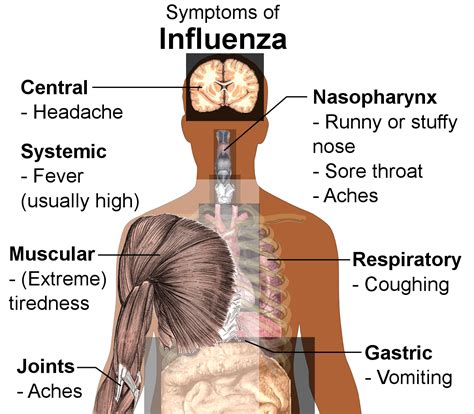Intro
Boost immunity with 5 ways to fight flu, featuring natural remedies, vaccination, and healthy habits to prevent influenza, flu symptoms, and seasonal outbreaks.
The flu season is upon us, and it's essential to take proactive steps to protect ourselves and our loved ones from this highly contagious and potentially severe illness. The flu, also known as influenza, is a respiratory illness caused by a virus that can lead to symptoms such as fever, cough, sore throat, and body aches. In severe cases, the flu can lead to complications like pneumonia, bronchitis, and even death. Therefore, it's crucial to know how to fight the flu and prevent its spread.
Understanding the importance of flu prevention and treatment is vital, especially for high-risk groups like the elderly, young children, and people with underlying health conditions. By taking simple yet effective measures, we can significantly reduce the risk of getting infected and minimize the severity of symptoms if we do get sick. In this article, we'll explore the best ways to fight the flu, from vaccination and hygiene practices to nutrition and lifestyle changes.
The good news is that there are many ways to prevent and treat the flu, and we'll delve into the most effective methods in this article. From the importance of vaccination to the role of nutrition and exercise, we'll cover it all. Whether you're looking to protect yourself or your loved ones, this article will provide you with the knowledge and tools you need to stay healthy and flu-free.
Understanding the Flu

Types of Flu
There are three main types of flu: A, B, and C. Type A flu is the most common and can be further divided into subtypes, such as H1N1 and H3N2. Type B flu is less severe than type A but can still cause significant illness. Type C flu is the mildest and rarely causes severe symptoms.Vaccination and Prevention

In addition to vaccination, there are several other ways to prevent the flu, including:
- Practicing good hygiene, such as washing your hands frequently and avoiding touching your face
- Avoiding close contact with people who are sick
- Staying home from work or school if you're feeling unwell
- Getting plenty of rest and staying hydrated
- Eating a healthy diet rich in fruits, vegetables, and whole grains
Benefits of Vaccination
The benefits of vaccination are numerous and well-documented. Vaccination can: * Reduce the risk of getting the flu by 40-60% * Prevent flu-related complications, such as pneumonia and bronchitis * Reduce the severity of symptoms if you do get sick * Protect vulnerable populations, such as the elderly and young children * Help prevent the spread of the flu in communitiesNutrition and Lifestyle

In addition to a healthy diet, regular exercise and stress management can also help prevent the flu. Exercise can:
- Boost the immune system
- Reduce stress and anxiety
- Improve mood and overall health
- Help prevent obesity and related health problems
Immune-Boosting Foods
Some foods are particularly effective at boosting the immune system and preventing the flu, including: * Citrus fruits, such as oranges and grapefruits * Berries, such as blueberries and strawberries * Leafy greens, such as spinach and kale * Nuts and seeds, such as almonds and chia seeds * Fatty fish, such as salmon and tunaTreatment and Management

In addition to medication, rest and hydration are essential for recovering from the flu. It's also important to practice good hygiene and avoid close contact with others to prevent the spread of the flu.
Home Remedies
Some home remedies can help alleviate flu symptoms, including: * Drinking plenty of fluids, such as water, tea, and soup * Using a humidifier to relieve congestion * Taking a warm bath or shower to relax and reduce fever * Using a saline nasal spray to moisturize the nasal passages * Getting plenty of rest and avoiding strenuous activitiesComplications and Risks

Other risks associated with the flu include:
- Exacerbation of underlying health conditions, such as asthma and diabetes
- Increased risk of heart attack and stroke
- Worsening of chronic health conditions, such as COPD and kidney disease
High-Risk Groups
Certain groups are at higher risk of complications from the flu, including: * Older adults, particularly those over 65 * Young children, particularly those under 5 * Pregnant women * People with underlying health conditions, such as heart disease and diabetes * People with weakened immune systems, such as those with HIV/AIDS or undergoing chemotherapyWhat are the symptoms of the flu?
+The symptoms of the flu include fever, cough, sore throat, body aches, and fatigue. In severe cases, the flu can lead to complications like pneumonia, bronchitis, and sinus infections.
How can I prevent the flu?
+You can prevent the flu by getting vaccinated, practicing good hygiene, avoiding close contact with people who are sick, and staying home from work or school if you're feeling unwell.
What are the treatment options for the flu?
+Treatment options for the flu include antiviral medications, over-the-counter medications, rest, and hydration. In severe cases, hospitalization may be necessary.
Who is at high risk of complications from the flu?
+Certain groups are at higher risk of complications from the flu, including older adults, young children, pregnant women, people with underlying health conditions, and people with weakened immune systems.
How can I manage flu symptoms at home?
+You can manage flu symptoms at home by drinking plenty of fluids, using a humidifier, taking a warm bath or shower, and getting plenty of rest. Over-the-counter medications can also help relieve symptoms.
We hope this article has provided you with valuable information on how to fight the flu and prevent its spread. Remember, prevention is key, and by taking proactive steps, you can significantly reduce the risk of getting infected and minimize the severity of symptoms if you do get sick. Share this article with your friends and family, and let's work together to stay healthy and flu-free this season!
